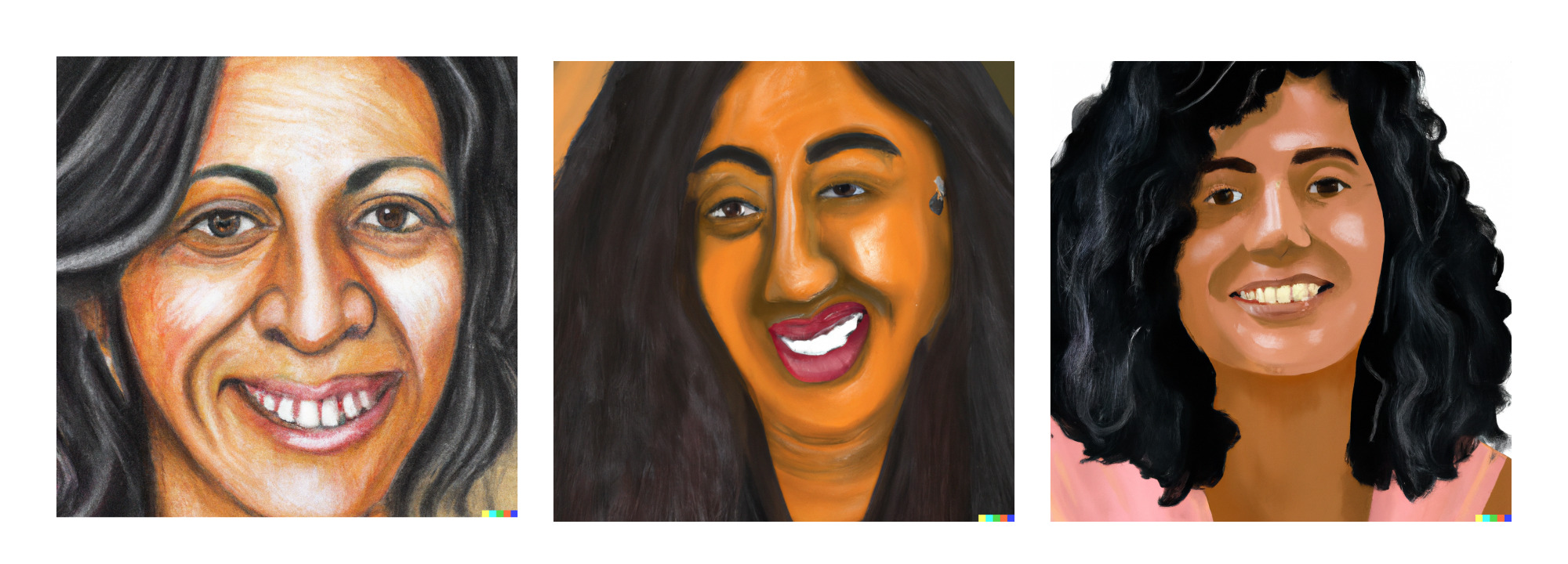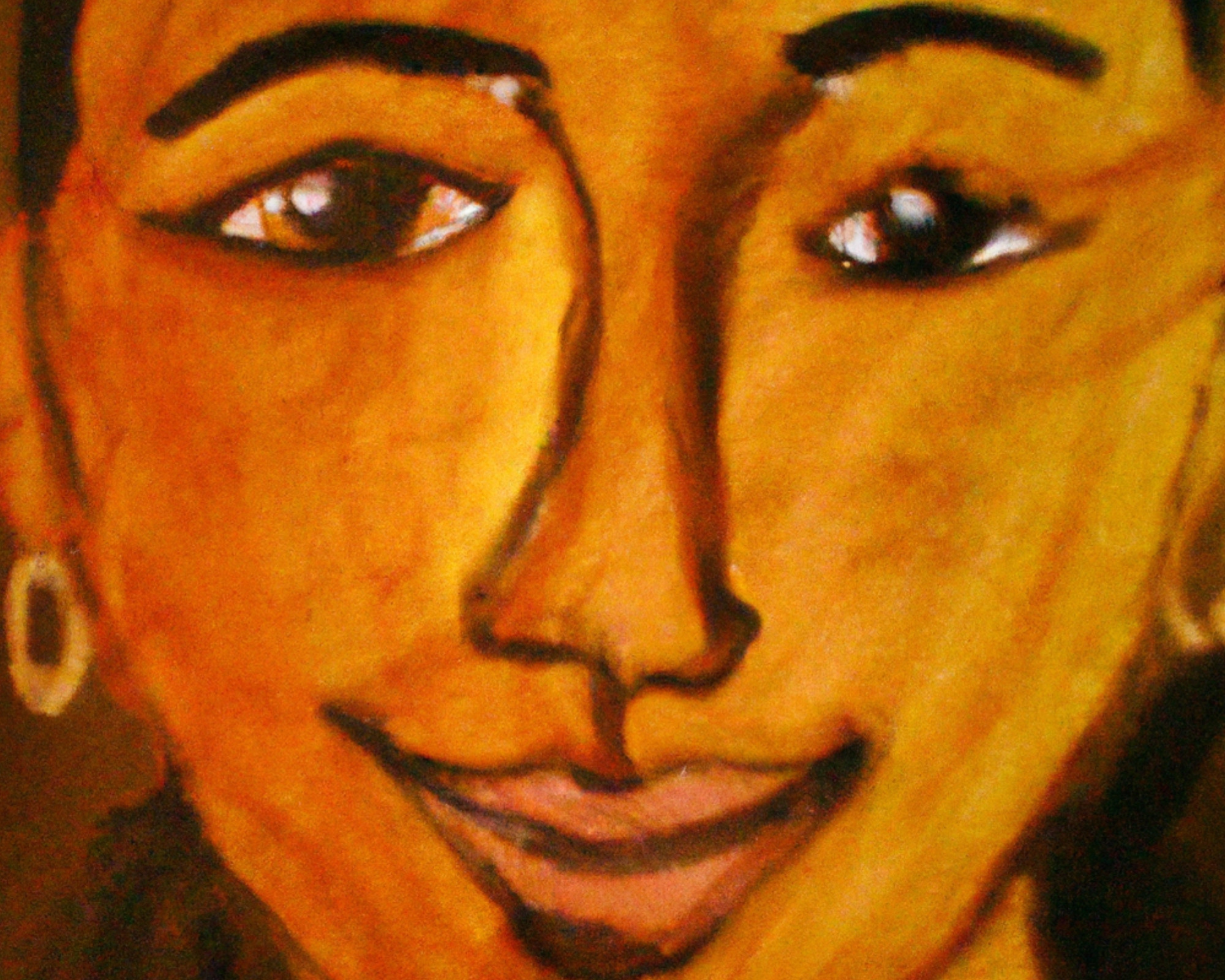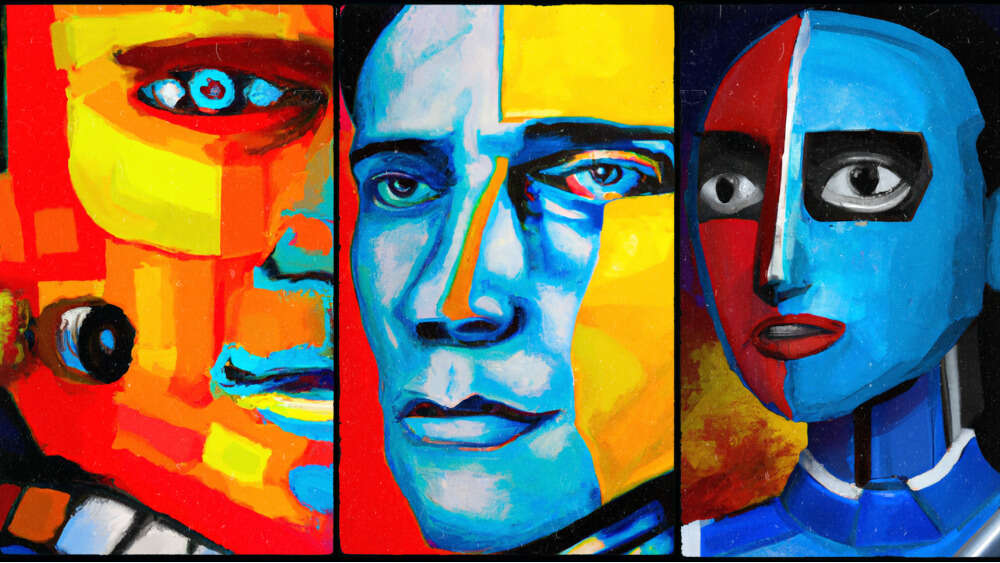Tech pundits and sci-fi writers have long speculated about the impacts of artificial intelligence (AI) on human life. Speculation is now real-world science as technology such as ChatGPT and DALL-E give a voice and visuals to what previously worked in the background of our digital lives.
Tracking the rapid advances in AI is exciting and troubling. Key concerns that emerged from a Pew Research project* on the topic of AI and the future of humans include loss of human agency, widening of structural inequality and economic disparity, data abuse, job loss, dependence lock-in and, naturally, MAYHEM.
If we boiled these down our question might be, how will AI affect what it means to be human?
With this “minor” question in mind, I began tinkering with AI art generator, DALL-E to see what it makes of humans. I launched with the prompt, “woman at home, window to outside world behind her, plants around her.” I had to make her brown-skinned because that’s a woman I always want to see more of. It wasn’t until I looked back at my DALL-E history of images that I realised something. What I was trying to see was me.

“brown-skinned woman at home, window to outside world behind her, plants around her” by DALL-E
The shape of me, this imperfect shell that hints at the messy soul within.
Once this dawned on me, I doubled down. “Racially ambiguous.” “Chic bob, but not like a grandmother,” which is what I say to my hairdresser. “Mid-sized” because that’s what I have to Google for images of clothes on a body like mine. “Wearing a blue dress.” I’ve never owned one, but that’s what I visualise; not as innocent as a pristine white gown, not as spicy as a red suit. Maybe the former Catholic tween in me channels a Madonna as my fashion muse? “Scarf on shoulder.” Again not a classic look for me, but the former Muslim child in me still reaches into the mental trove of colourful hijabs that my aunties collected for formal occasions with the posh and more religious side of our family.
Every time I hit that “generate” button I held my breath for a moment to see what this technology could show of me. With each set of results, I was amused and disturbed but never truly satisfied.

“woman reading in a peaceful place” Please explain, DALL-E…
It wasn’t me.
Perhaps I’m too close to the subject? Portraiture is, after all, a representation. The artist’s impression of what they see. In this case, was the artist me or AI?

“21st Century portrait of South African woman smiling” by DALL-E
AI cannot know my inner world, no matter what I feed it. How could I summarise that changeable place inside of me that is at times at peace, at times turbulent? And what of the things I can’t articulate, the things I scarcely know myself?
Could AI ever know itself as we attempt to know ourselves? Could AI know its human creators as we know our Creator – not only through data points but through presence and love?
Human intelligence vs networked intelligence

“portrait of a robot” by DALL-E
When we pit human intelligence against networked intelligence in the arenas of calculation, information aggregation and speed, humans are found wanting. The Nobel Prize-winning research in Daniel Kahneman’s book, Thinking Fast and Slow, painstakingly details our susceptibility to cognitive biases, which lead to errors in memory, judgment and decision-making.
The value of a human being is much more than how optimally we think or perform.
AI cannot know my inner world, no matter what I feed it.
We each have a unique story and perspective. We have empathy, self-awareness, boundless creativity, the ability to connect with other humans and the capacity to connect with God, who is outside our understanding.
A human is just not a learning machine, we are actively interacting with and participating in life. Shaping it and being shaped by it.
A human has not only a brain, but also a mind and spirit and a heart.
The strangeness of the human heart

“portrait of a smiling brown-skinned woman” by DALL-E
The human heart, our deepest desires and fears, is hidden; known by God and, if we’re lucky, by the people closest to us. The heart is unpredictable. Both fervent and fickle, sometimes wise and sometimes really dumb. John Donne’s Holy Sonnet 14 expresses this complexity with painful precision.
Batter my heart, three-person’d God, for you
As yet but knock, breathe, shine, and seek to mend;
That I may rise and stand, o’erthrow me, and bend
Your force to break, blow, burn, and make me new.
I, like an usurp’d town to another due,
Labour to admit you, but oh, to no end;
Reason, your viceroy in me, me should defend,
But is captiv’d, and proves weak or untrue.
Yet dearly I love you, and would be lov’d fain,
But am betroth’d unto your enemy;
Divorce me, untie or break that knot again,
Take me to you, imprison me, for I,
Except you enthrall me, never shall be free,
Nor ever chaste, except you ravish me.
– Holy Sonnet 14, John Donne
To be a human, in pursuit of and being pursued by God, is a wild ride. To live in this chaotic world takes courage and faith. It cannot be codified or measured by a range of outcomes. To be human is to rise and fall. To wake up each day and somehow believe that today will be worth putting on pants for.
Though other humans have hurt us in our past, we have this capacity to trust and to love completely. Though we fail a thousand times, we can regroup and try again. Though we find delicious instant gratification in temporal things, we can make space for the quiet rhythm of prayer. Though credibility and success depend on being recognised for what we do, we find our greatest satisfaction in doing something unseen and unacknowledged for someone in need.
For such a time as this, however, we need to dig into what it means to be human.
Should we stay informed and weigh in where we can on questions of ethics, truth and fairness when it comes to AI? Absolutely. Should we make a personal and corporate commitment to empathy, critical reading and responsible information sharing? It goes without saying!
Above all and for such a time as this, however, we need to dig into what it means to be human.
We are created in the image of God. To discover this will mean going beyond our needs and experiences to pursue God for himself alone. It means reinvigorating our personal and private pursuit of God through prayer, studying the Scriptures and quiet contemplation. It’s in this beautiful communion that he shapes us to become truly human because we are becoming more like him.
This truth is captured in 2 Corinthians 3:16-18: “whenever anyone turns to the Lord, the veil is taken away. Now the Lord is the Spirit, and where the Spirit of the Lord is, there is freedom. And we all, who with unveiled faces contemplate the Lord’s glory, are being transformed into his image with ever-increasing glory, which comes from the Lord, who is the Spirit.”

“portrait of a smiling brown-skinned woman” by DALL-E
As I evaluate the portraits that DALL-E and I created, I wonder about the future of this technology. The race is on to attain artificial general intelligence (AGI), where a computer could solve complex problems, learn from them and plan for the future. What comes after that? Is sentient AI a possibility in my lifetime? If researchers could create something akin to a human heart, would they attempt to fix it? Make it less errant and more reliable, less stubborn and more compliant.
But what would be the point of that?
It is in our woeful weakness that we collide with, and truly behold, the gift of grace. It’s in our imperfect condition that we experience true love. The beautiful paradox is that our greatest liability is in fact our greatest asset.
* In 2018 Pew Research interviewed 979 technology experts on the topic of AI and the future of humans
Email This Story
Why not send this to a friend?


